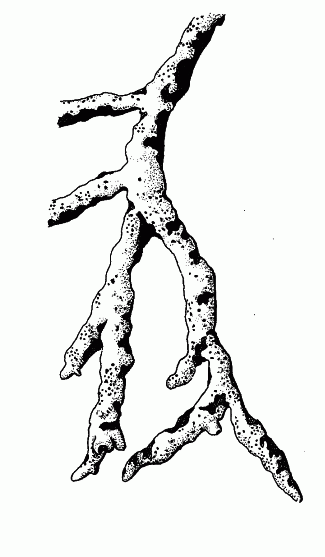Hypogymnia heterophylla Pike
Seaside bone
Parmeliaceae
Introduction to the Lichens
Seaside bone
Parmeliaceae
Introduction to the Lichens
Map
Distribution of Hypogymnia heterophylla unavailable
Species Information
General:
Common Name: The Bone Lichens. Stresses the hollow lobes of the species and the pale, often whitish, upper cortex.
Small to medium stratified foliose lichens, corticate above and below, sorediate or rarely isidiate or not, lobes rather loosely appressed to semi-erect or pendulous, hollow, occasionally perforate, 0.5–5 mm wide. Upper surface usually pale greyish, occasionally brownish. Lower surface blackish, shiny, wrinkled, lacking rhizines. Medulla white. Photobiont green.
Apothecia located over upper surface, often stalked/stipitate, disc usually concave, brown; spores simple, spherical to ellipsoid, colourless, 8 per ascus.
Notes: Hypogymnia is essentially a temperate genus of about 50 species worldwide. Twenty species occur in North America and 17 in B.C. The western Hypogymniae display a highly varied chemistry and spot tests are helpful in distinguishing between species. Note that what is usually referred to as a PD- medullary reaction in Hypogymnia may sometimes actually be discerned as PD+ pale yellow. In this case, however, the coloration is usually restricted to the upper portion of the medulla, while the lower portion remains white. By contrast, a “true” PD+ pale yellow reaction (e.g., as for H. rugosa) registers across the entire medulla, from top to bottom. Applying as little reagent as possible will help avoid ambiguity. Brodoa oroarctica was formerly treated within Hypogymnia.
Species description:
Soredia absent AND
Upper surface pale brownish or more often whitish grey; lobules, if present, along margins; isidia absent; over bark and wood; variously distributed AND
Medullary ceiling distinctly dark almost throughout AND
Upper surface distinctly and strongly convex throughout (including near lobe tips), also often swollen; basally constricted marginal lobules present or absent AND
Lobes usually ascending; lobe tips mostly tapered and broadly pointed; perforations absent or restricted to lower surface; strictly coastal AND
Lobes strongly and irregularly side-branched(¬); medulla PD+ yellow becoming bright orange; rare
Reactions:
Cortex K+ yellow; medulla KC+ red, PD+ yellow becoming red.
Contents:
Atranorin, physodalic acid, physodic acid and protocetraric acid.
Source: Lichens of British Columbia
Illustration

If more than one illustration is available for a species (e.g., separate illustrations were provided for two subspecies) then links to the separate images will be provided below. Note that individual subspecies or varietal illustrations are not always available.
Illustration By: Trevor Goward
Habitat and Range
Habitat: Infrequent over conifers, especially shore pine (Pinus contorta), in open coastal localitiesWorld Distribution: western N Am, N to BC, S to CA.
Source: Lichens of British Columbia
Status Information
| Origin Status | Provincial Status | BC List (Red Blue List) | COSEWIC |
|---|---|---|---|
| Native | S2 | Red | T (Mar 2008) |
BC Ministry of Environment: BC Species and Ecosystems Explorer.